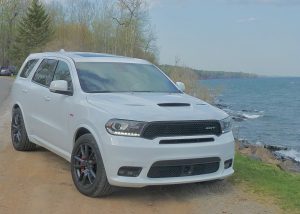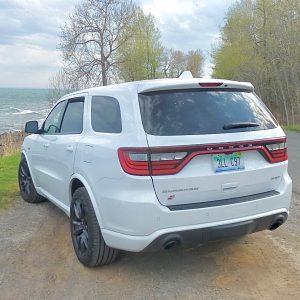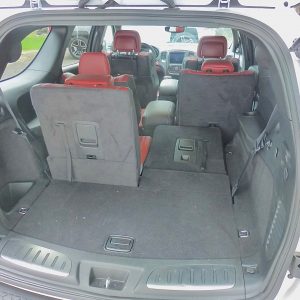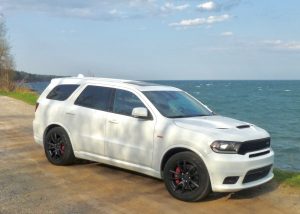Durango gets racier with SRT 6.4 Hemi
By John Gilbert
Memorial Day weekend is celebrated by many as the ultimate race weekend, mainly because of the Indianapolis 500. Fittingly, then, our subject during Indy week is a vehicle that not only embraces the American drivers’ love of speed with the American family’s current love of SUVs
We’re talking the Dodge Durango SRT 392, and the test vehicle came in a gleaming white paint exterior, called, cleverly enough, “White Knuckle,” a clearcoat finish that makes its point: Drive this beast, but be ready for lightning quick power requiring maximum driver attention.
If this all seems familiar, it might be because loyal readers of New Car Picks may recall seeing an all-white hot-rod Dodge Durango, just a few months ago. It was the Durango GT, which came with almost all the visual tricks of the SRT, and with a properly spunky 3.6-liter V6 and an option available up to the 5.7-liter Hemi V8.
But it is time to give the Durango SRT 392 its moment in the sun, partly because of the tie-in with Race Weekend, and because the SRT 392 could leave all other Durangos in the weeds. This is more like a Dodge Charger SRT with three rows of seats and a bit more road clearance. And it is just as hot as the car-version Charger or Challenger SRT, because it has the same powertrain.
The SRT — for street, racing technology — gang hangs out behind the scenes at Dodge, thinking up ingenious ways to get more power out of its pride-and-joy Hemi V8 engines. The “392” is the monster engine, a 6.4-liter V8 fastened to an 8-speed heavy-duty transmission and steering wheel paddles, just in case the highly efficient transmission doesn’t up- or downshift quickly enough.
Trust me on this: Everything the Durango SRT 392 does it does swiftly enough for any normal performance-driving zealot. With all the firming-up and strengthening of the powertrain and suspension, the SRT 392 sticker price was $75,550. That’s a healthy leap from the more basic models’ range of mid-$30,000 to $60,000, but those who select it are not interested in moderation from a vehicle or its drivetrain or its image. And yet, while the more basic Durango won’t do what the sizzling SRT will do, the SRT 392 will easily settle in and do what a family hauler will do.
For a large SUV, with three rows of seats, which in the test-vehicle’s case are “Demonic Red,” covered with Laguna leather, which apparently is red. The front buckets are wonderfully supportive, for the kind of no-lean hard cornering the Durango SRT invites, and the second row i
s also reclinable and comfortable, and can fold away forward to allow access to the third row bench.
Sitting in the second row is certainly no handicap. Visibility is good, and if you don’t like it, you can flip open the DVD screen and watch something other than scenery zip by. There also is a neat and efficient little panel on the rear-facing end of the front console, which includes an assortment of connectivity things to handle charging, or control of the DVD or Blue-R
The seats, naturally, open the storage capacity to tremendous potential, but that’s about as far as the nod toward family SUVs goes. Otherwise, this is a Durango meant to go — fast, strong, under control, and with great stability.
Visually, the stark white exterior sets off the black grille and trim pieces more dramatically than any color would. With the grille coming right out of the headlights and the lower opening and foglight enclosures all in place, the Durango SRT makes a dramatic entrance, wherever you’re going. Driving through town draws double-takes and repeated stares, just because the vehicle with its 20-inch black alloy wheels serves notice that it’s something special.
If you couldn’t see it, you could still hear it, and it is a beautifully melodic rumble achieved whenever you launch with a moderate to heavy hit on the gas.
Alas, I never did get the Durango SRT 392 off on any lengthy trips, because the interior accommodations begged me to, but just around town and with occasional short highway jaunts, we attained about 18.5 miles per gallon. The EPA estimate for the 6.4-liter monster engine is 19 highway, so we were right on it, and we easily exceeded the 13 city and 15 combined miles per gallon suggested by the EPA.
The way the Durango SRT handles is a credit to Dodge chassis engineers, who have had a lot of experience recently. The high-performance suspension and the performance tuned steering, which is pleasantly heavier as an aid to hard cornering more than parallel parking, and things like Brembo brakes and configurable drive modes all contribute to performance driving, even with the whole family on board.
Lane-departure warning, and forward collision warning are also the sort of thing all vehicles can benefit from. Four-wheel traction control and real-world safety features such as rear back-up camera, remote start and keyless entry all come together regardless of which driving extreme you might choose for a given day. Or any given track day.








 John Gilbert is a lifetime Minnesotan and career journalist, specializing in cars and sports during and since spending 30 years at the Minneapolis Tribune, now the Star Tribune. More recently, he has continued translating the high-tech world of autos and sharing his passionate insights as a freelance writer/photographer/broadcaster. A member of the prestigious North American Car and Truck of the Year jury since 1993. John can be heard Monday-Friday from 9-11am on 610 KDAL(www.kdal610.com) on the "John Gilbert Show," and writes a column in the Duluth Reader.
John Gilbert is a lifetime Minnesotan and career journalist, specializing in cars and sports during and since spending 30 years at the Minneapolis Tribune, now the Star Tribune. More recently, he has continued translating the high-tech world of autos and sharing his passionate insights as a freelance writer/photographer/broadcaster. A member of the prestigious North American Car and Truck of the Year jury since 1993. John can be heard Monday-Friday from 9-11am on 610 KDAL(www.kdal610.com) on the "John Gilbert Show," and writes a column in the Duluth Reader.